Last updated: July 30, 2024
Dublin is Ireland’s capital and largest city and is located on the east coast.
Like in the rest of Ireland, there are two official languages spoken here: Irish (Gaelic) and English, so don’t be surprised about bilingual signs!
For many tourists, Dublin is the gateway to their Irish adventures, which is why I chose this city as the first part of my Ireland Travel series! 😀 We spent four days in Dublin in August 2022, which is a perfect amount of time before moving on to other places.
Disclosure: I only recommend products that I’ve used in the past, and all opinions expressed in this post are my own. This post contains affiliate links. If you use one of the links throughout the page to buy something, I may earn a small commission at no extra cost to you. Thanks!
Things to See and Do in Dublin
The Guinness Storehouse
Address: St. James’s Gate, Dublin 8, D08 VF8H, Ireland
First, stop at the Guinness Storehouse, which tells the story of Ireland’s most famous beer! It’s a seven-floor building at St. James’s Gate and used to be the fermentation plant of the brewery. Since opening its doors in 2000, more than 20 million people have been to this iconic attraction!
Visitors learn about the four ingredients needed to make Guinness, the brewing process, and how it’s been stored and transported around the world. You’ll even “meet” Arthur Guinness (the inventor)! Equipment that was used for brewing Guinness is displayed as well.
Moreover, don’t miss the many advertising slogans that promoted Guinness over time, and you can even learn to pour your own pint at the Guinness Academy!

The Guinness Storehouse entrance gate.
For a pick-me-up during your visit, take a seat at the Cooperage Café or Arthur’s Bar and 1837 Bar & Brasserie, that are ready to serve hot and cold drinks, snacks, and traditional Irish food!
Once you get to the 7th floor, you deserve a free pint of Guinness at the Gravity Bar, as well as a 360° panorama view of Dublin! Lastly, buy some cool souvenirs at the gift shop, like t-shirts, hats, pint glasses, socks, magnets, key chains, coasters, and even Guinness chocolates!
Ticket admission is 20 EUR for a self guided tour of the Guinness Storehouse. Or you can book a special experience, such as the STOUTie Experience, which includes your selfie being printed on a Guinness beer! You can find more info on this in Tom’s post.



From left to right: Barrels used to store Guinness, ship for transporting the beer around the world, and 360° view of Dublin.
Trinity College
Address: College Green, Dublin 2, Ireland
Trinity College was founded back in 1592 by Queen Elizabeth I and is Ireland’s oldest university. Many famous Irish people went to school here, including Oscar Wilde, Sally Rooney, Samuel Beckett, and Douglas Hyde (Ireland’s first president).
But the most popular spot of Trinity College is the Book of Kells exhibition. It’s a 680-page manuscript written in the 9th century AD, that, according to the Book of Kells Facebook page, “is Ireland’s greatest cultural treasure and the world’s most famous medieval manuscript”.
Every day one page is turned, so it takes 170 days to finish this book. Moreover, the Long Room inside the Old Library, which opened in 1732, has 200,000 ancient books, as well as Ireland’s oldest harp (built in the late Middle Ages)!
It’s strongly recommended to purchase tickets online for a timed visit of 30 minutes (starting at 25 EUR) to guarantee entry into the exhibit.


Entrance of Trinity College (Photo by Stephen Bergin on Unsplash) and The Long Room (Photo by Hanna May on Unsplash).
It’s fun walking on the cobblestoned paths of the campus, looking at the amazing Georgian and Victorian buildings, such as the Campanile (completed in 1853), and the ‘Sfera con Sfera’ (Sphere Within Sphere) bronze sculpture by Arnaldo Pomodoro (1982/83).


The ‘Sfera con Sfera’ bronze sculpture and a part of the campus grounds.
You can book self-guided or guided tours around the campus and the Book of Kells exhibit. Lastly, it’s possible to book rooms (single/twin/double or apartments) at the Trinity College Campus and Dartry (15 minutes from the campus) during the summer months.
Temple Bar District
Temple Bar is Dublin’s cultural quarter and nightlife hotspot. It’s right next to the riverbank of the Liffey, which flows through downtown.
Temple Bar used to be a wealthy neighbourhood in the 17th century. But this changed drastically in the 1800s, when it was one of Dublin’s main red-light districts! It was still a crappy area towards the end of the last century, but in 1991, it was modernized.
Today, the most famous spot is the bright red Temple Bar Pub (47-48 Temple Bar, Dublin 2, D02 N725), where you can check out Ireland’s largest Whiskey collection and it has live music every day. This pub was established in 1840, and is known for its flower decorations outside, low hanging lamps, and a bronze statue of James Joyce.

The Temple Bar Pub (Photo by Leonhard Niederwimmer on Unsplash).
The Temple Bar district has many other pubs, night clubs, cafés, restaurants, hotels, hostels, and lots of shopping opportunities, but is also home to many art galleries and the Irish Film Institute (6 Eustace St, Temple Bar, Dublin 2, D02 PD85).
Thanks to its high popularity with tourists and locals, this area can be pretty crowded. Moreover, it’s often more expensive than in other parts of Dublin, and petty crime, like scams and pickpocketing, can happen sometimes.

The Liffey River.
The Irish Rock’n’Roll Museum
Address: Curved St, Temple Bar, Dublin, D02 RD26, Ireland
If you love Irish music, there’s no way to miss the Irish Rock’n’Roll Museum! The Wall of Fame outside, that displays many Irish Rock’n’Roll legends, including U2, Rory Gallagher, Thin Lizzy, and Sinead O’Connor, is a great first impression of this place!
We join a guided tour and look at a bunch of vintage guitars and records by Irish musicians, like The Cranberries, Enya, The Undertones, and The Boomtown Rats.

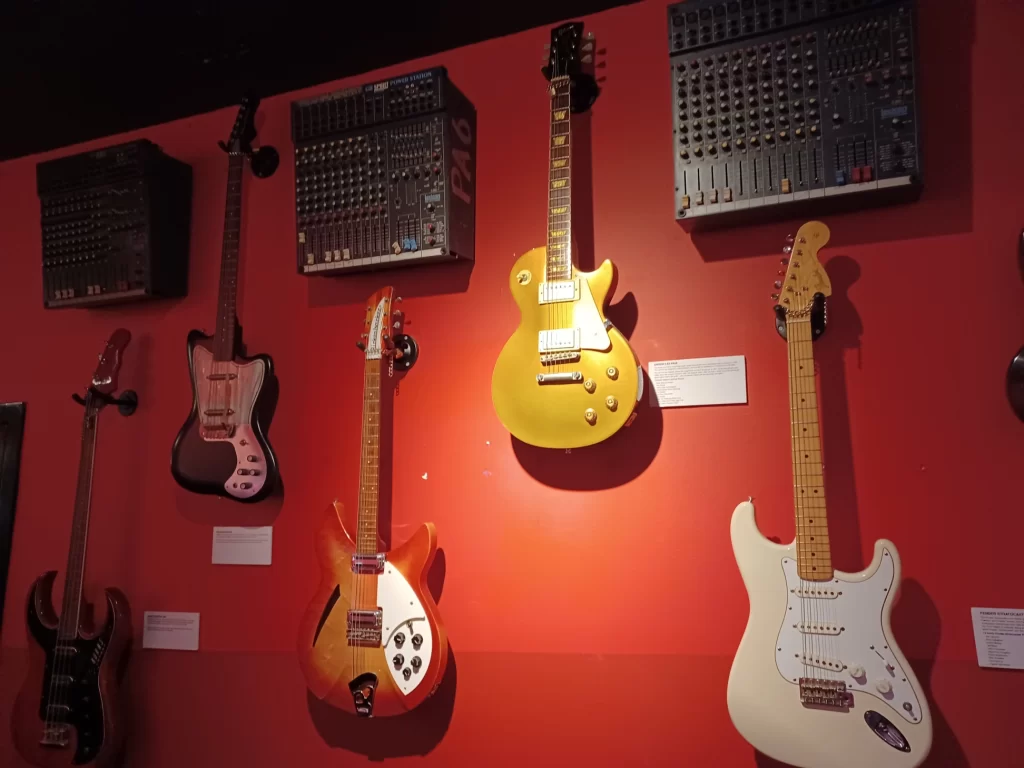

Next, there’s Michael Jackson’s pajama and a jacket he wore while touring with the Jackson 5 (Fun fact: He lived in Ireland for a while in 2006!). After watching a short movie about Irish Rock’n’Roll legends, we move to a room dedicated to U2, that has tons of exclusive material!
But this place is not just a museum, as it also has a recording studio (Rihanna and The Script recorded here) and the Button Factory. The latter is a music venue and to get the real Rock Star feeling, we jump on stage as well!



Moreover, this is Dublin’s major rehearsal space for unknown and famous bands. As we enter one of these rooms, Brian, our guide, suddenly encourages the musicians in our group to start a jam session! Then we check out Thin Lizzy’s recording studio and a selection of Phil Lynott’s guitars and a jukebox.
Lastly, we find a few things related to Rock legends who have Irish roots, like Johnny Rotten’s sleeveless jacket, a Nirvana gig poster, and Beatles memorabilia! The Irish Rock’n’Roll Museum is open 7 days a week, ticket admission starts at 22 EUR and only guided tours can be booked at this time.


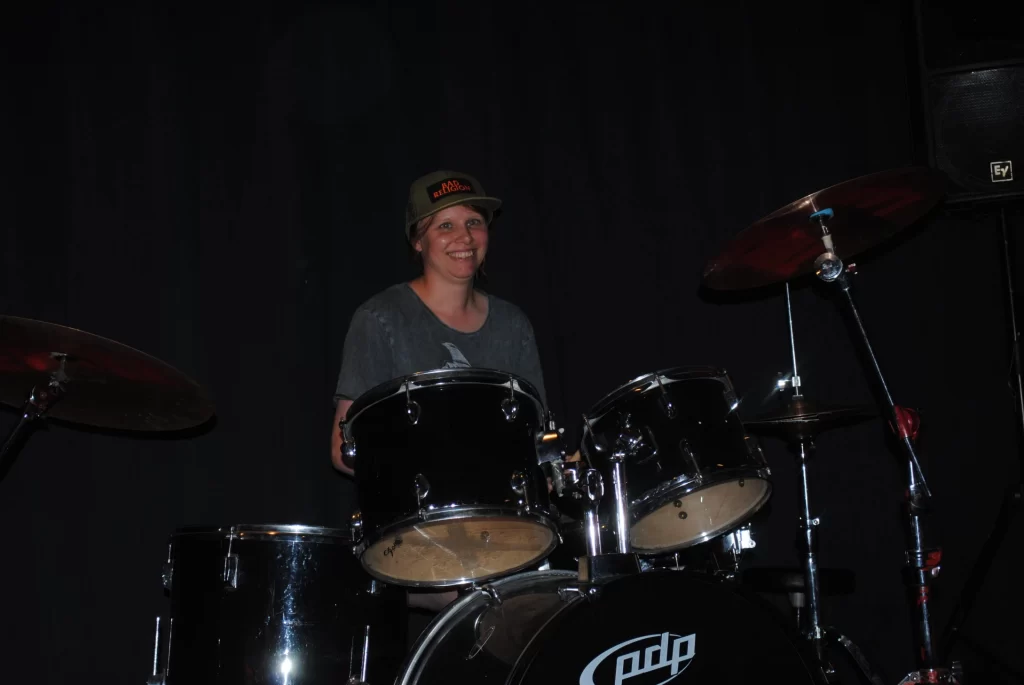
Johnny Rotten’s jacket, Thin Lizzy’s recording studio, and a drummer in action!
Phoenix Park
Need a break from the busy city now? Then hang out for a couple hours at Phoenix Park. It’s perfect for walking, having a picnic, playing sports, and relaxing. You can also rent a bike with Phoenix Park Bikes (Chesterfield Ave, Saint James’ (part of Phoenix Park), Dublin 8, D08 DF88) at the main entrance, and ride along the park’s 14 km (8.69 miles) of cycle trails.
It was founded in 1662 as a royal hunting area and has been open to everyone since 1747. At 1,750 acres, it’s Europe’s largest city centre park (it’s twice the size of Central Park in New York City!).
The Irish President lives at the Áras an Uachtaráin residence inside the park, same as about 600 wild fallow deer, which have been here for many years, and are free to move wherever they like! There are ponds to look at, a Visitor Centre, the Papal Cross, Victorian Flower Gardens, a Biodiversity Information Centre, Phoenix Café, and Tea Rooms as well.
Lastly, you can also find the Wellington Monument inside Phoenix Park. It’s Europe’s tallest obelisk, and was built to honour the Duke of Wellington in 1817, who’d beaten Napoleon two years earlier. But the builders ran out of money, so it wasn’t completed until 1861, after he’d already died!




St. Stephen’s Green Park
St. Stephen’s Green Park has 750 trees with a Victorian layout and is right in the heart of Dublin. Until 1664, it was a marshy common for sheep and cattle to graze and even public executions and witch burnings happened here!
In 1877, Arthur Edward Guinness (Arthur Guinness’s great-grandson) asked the City of Dublin to open St. Stephen’s Green to the public, which was done in 1880.
The park also played a role during the Easter Rising of 1916, when rebels of mainly the Irish Citizen Army dug trenches and took it over. St. Stephen’s Green Park also has several monuments, like a bronze statue of Theobald Wolfe Tone, the leader of the Irish rebellion in 1798. There’s also a memorial to the Great Famine from 1845 to 1849.
Many birds and plant species live inside St. Stephen’s Green Park. There’s also a playground, the Ardilaun Lodge (Superintendent’s Lodge), built shortly after 1880, flowerbeds, waterfall, as well as a garden for the visually impaired.



Grafton Street
There are many stores and shopping malls in Dublin, so get your credit card ready to be maxed out! A popular shopping spot is Grafton Street, a pedestrian street only minutes away from St. Stephen’s Green Park.
There are tons of shops, like The North Face, Disney store, Levi’s, but also the Card Gallery, Ulysses Rare Books, the Irish Design Shop, and Aran Sweater Market (handknitted Irish wool clothing).
It’s also a great for watching street performers and buskers, especially during the summer. Some well-known musicians started their career while busking here, such as Bono, U2’s lead singer. He also plays here every year on Christmas Eve, to help the homeless people of Dublin. How cool is that?
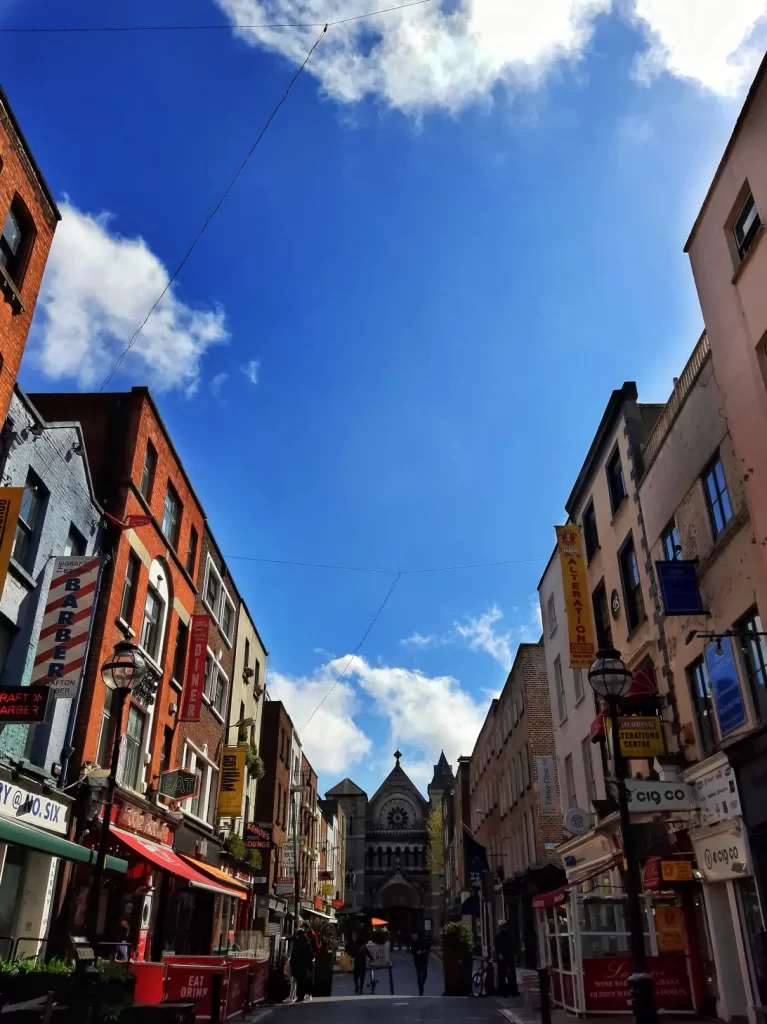
St. Stephen’s Green Shopping Centre
Address: St Stephen’s Green, Dublin, D02 HX65, Ireland
Next, check out St. Stephen’s Green Shopping Centre, which has many European and Irish chain stores, like Game Stop, Flying Tiger, Butler’s, Eason Books, United Colours of Benetton, and Carroll’s Irish Gifts.
The latter sells jewelry, Irish-style (shamrock) clothing, chocolates, tea towels, green Leprechaun top hats, bookmarks, and more! We also like the design of this shopping centre, especially the large clock and all the balloons!
George’s St. Arcade
Address: South Great George’s Street, Dublin, Ireland
George’s St. Arcade is a market inside a lovely Victorian-style red brick building in downtown Dublin and is perfect if you’re into unusual stuff! It’s been around since 1881, and has several independent shops and stalls with vintage clothes, records, jewelry, book store, crafts from Asian countries and West Africa, and many more!
My favourite is Elevation Music Movies Comics, which, sells cool vintage music and movie prints, comic book merch, buttons, patches, key chains, and magnets!
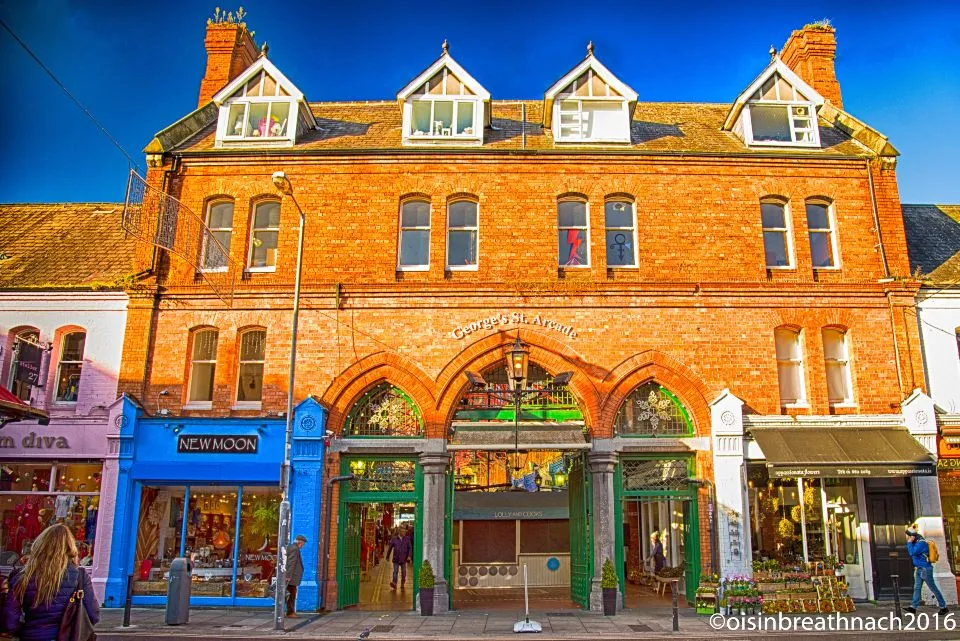

George’s St. Arcade from the outside (Photo credit: The Layden Group) and a poster print of Nirvana’s Unplugged Concert!
Join a Guided Bike Tour with Lazy Bike Tours
A great way to see lots of Dublin’s downtown attractions is through a guided bike tour. We join a tour with Lazy Bike Tours, which takes about 2.5 hours, and you can rent a push bike (cruiser bike) or e-bike.
Our first stop is Dublin Castle (Dame St, Dublin 2), that was built in the early 13th century. But the powder storage of the castle exploded in 1684, that’s why the round tower (right side of the photo below) is the only original part still intact today. The hard dirt that was left from the explosion was later turned into a Georgian palace.
Next, we look at St Patrick’s Cathedral (St Patrick’s Close, Dublin, D08 H6X3), completed in 1260, which is one of the few medieval buildings in Dublin that still exists. You can also find Jonathan Swift’s grave here and there’s a nice park right next to the cathedral.
When we arrive at the Teeling Whiskey Distillery (13-17 Newmarket, The Liberties, Dublin 8, D08 KD91), opened in 2015, we learn that it’s the first distillery that opened in more than 125 years! Ireland’s whiskey making history started in the middle ages.
Fast forward to the 1800’s, a production boom happened, with 30 distilleries all over the country. But in the 20th century, the industry declined drastically, because of the damage due to the two World Wars, civil wars in Ireland, and a changed consumer taste preference.


St Patrick’s Cathedral.
We also stop at The Liberties, Dublin’s oldest working class neighbourhood. In the 12th century, when Dublin was a walled city, this area was one of its suburbs. Many distilling and brewing families (including the Guinness family) lived here. The Guinness brewery is still here today, that a very optimistic Arthur Guinness leased in 1759 for 9,000 years!
You can also find many antique shops and small shops, that sell all kinds of knick-knacks. As we get to the Guinness Storehouse, Laura, our guide, tells us that Arthur Guinness was advised by businessmen that he’d be more successful producing whiskey instead of beer, as it was perceived as the “poor people’s drink”. Who knows what would have happened if he’d listened to them?!

We also ride by some amazing Guinness street art murals painted by Holly Pereira.


The most touching stop of this tour is the Kilmainham Goal Museum (Inchicore Rd, Kilmainham, Dublin 8, D08 RK28). Criminals (especially revolutionaries fighting for Ireland’s independence) were imprisoned and executed here from 1796 until 1924.
In May 1916, a total of 14 Irish rebels were shot by the British Army at the Stonebreakers’ Yard of this prison, soon after the Easter Rising had occurred.
Today, visitors can look at 14 bronze sculptures across the street, which were put up to honour these brave men. They are standing in a circle, blindfolded and each one has holes where the bullets hit them.

EPIC – The Irish Emigration Museum
Address: The Chq Building, Custom House Quay, North Dock, Dublin 1, Ireland
If you want to learn more about Ireland’s history, the EPIC – The Irish Emigration Museum should be on your list!
These days, more than 70 million people worldwide (many in North America, Australia or New Zealand) have Irish heritage, even if they never met their ancestors.
First, you find out why many Irish people emigrated, whether it was extreme poverty caused by the Great Famine (1845-1852), oppressive laws from the government, civil wars, forced labour, a weak economy, or a lack of jobs. Others were looking for a romantic partner or land to buy abroad.
You can also watch lots of short movies that show the Irish emigrants’ hopes and fears, which are very moving and read some of the questions they were asked upon entering their new home land.
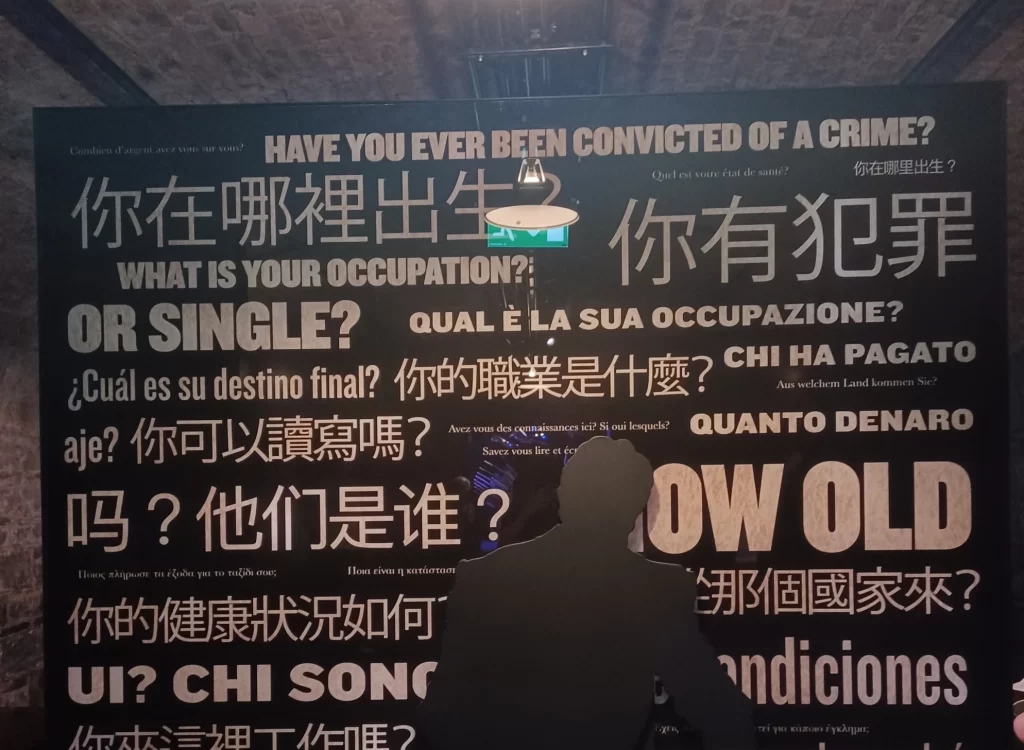

As the tour goes on, visitors learn how the Irish culture and identity have changed the rest of world. Many Irish communities were formed overseas with time and emigrants were happy to share traditional Irish music and dance with their peers, which started in the mid-1800’s.
Other Irish migrants and/or their descendants became politicians, actors, musicians, authors, journalists, directors, athletes, scientists, and so on. For example, did you know that several Canadian and Australian prime ministers and US presidents have Irish roots?
Irish food and drinks have travelled the world, too, which is why today, we have at least one Irish pub in many bigger cities and Guinness and Jameson’s Whiskey are famous! And let’s not forget about the many St Patrick’s Day celebrations worldwide on March 17th each year!
Wow, the EPIC Museum was just awesome! Every visitor gets the EPIC Passport at the start of their tour, which gets stamped after each section is completed. You can also visit the Irish Family History Centre to find out about your Irish ancestors.
Self-guided entry ticket admission starts at 21 EUR for adults and you can download a free audio guide in various languages to your phone. The museum is also fully wheelchair accessible.



Politicians and hit albums by musicians with Irish roots and books written by Irish writers.
Samuel Beckett Bridge
Only a few steps from the museum you can find the famous Samuel Beckett Bridge, a cable-stayed swing bridge shaped as a harp. It’s one of Ireland’s traditional musical instruments and a big part of Irish culture.
It crosses the Liffey River, is 120 meters (390 ft) long and 48 meters (157 ft) high and was completed in 2009. Since then, it has become one of Dublin’s major landmarks.

Dublin’s Street Art
Dublin also has more cool street art to look at and we even saw a very colourful piano inside Connolly train station:



Where to Eat & Drink in Dublin
If you’re looking for craic (Irish slang for good times ;)), you can’t miss Dublin’s diverse food scene!
Here are our favourites:
Camden Bites & Brews (9 Camden Street Lower, Saint Kevin’s, Dublin, D02 FX67). This fun bar and restaurant is open daily and is known for Italian coffee and cold drinks, DJ nights, and has hosted a flea market several times.
They serve lots of pub food, like burgers, wings, Fish & Chips, calamari, and chunky fries. We’re having a Beef Burger and Piccolo Vegan Burger and they are both really good! There’s also an outside terrace and we love the chessboard floor design!
The Little Pyg (59 William St S, Dublin 2, D02 E521). Wow, what an unusual name! This restaurant is inside Dublin’s Powerscourt Townhouse Centre and they serve authentic Neapolitan pizza, as per Michelin Maestro Enzo Coccia’s recipe.
We order their Tomato Soup and Mushroom Ravioli, which are very tasty, although the portions are a bit small for the price… But even though this restaurant is inside a busy mall, it’s got a chill vibe and the staff was very friendly and efficient.
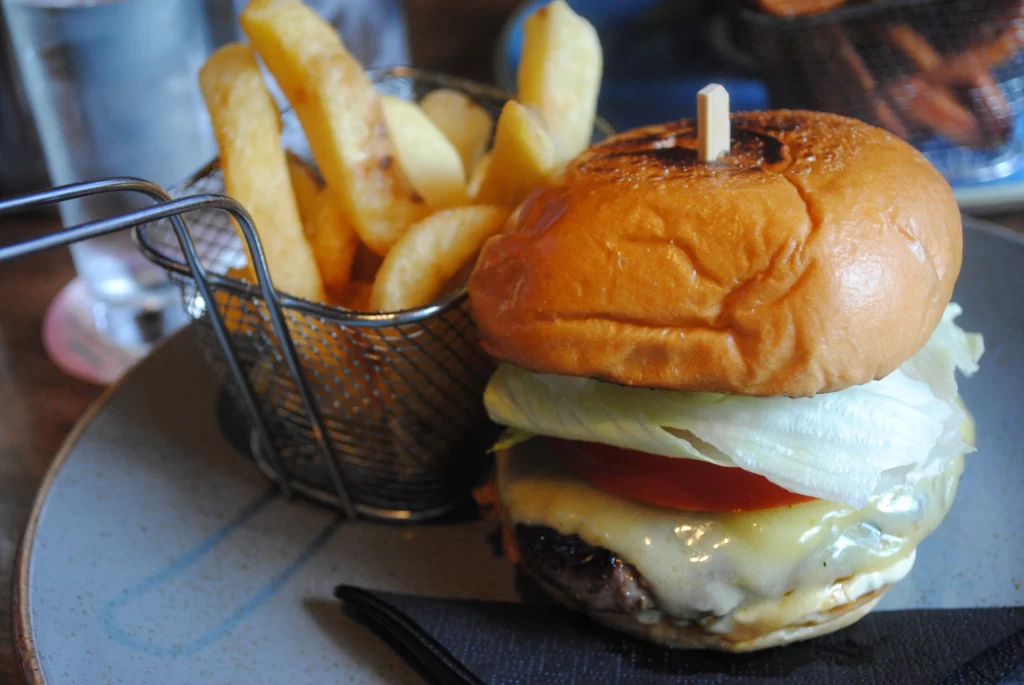

The Hard Rock Café (12 Fleet St, Temple Bar, Dublin, D02 NW56). This iconic chain restaurant is right in the heart of the Temple Bar district. We’re having The Big Cheeseburger and Cauliflower Wings, and some Guinness, so good! They even have a Guinness Burger, but like in any of their locations, it’s not just about the food and drinks, but also about all the Rock memorabilia on the walls.
So while you’re waiting for your grub, check out Brian Johnson’s tweed hat, Jimi Hendrix’s silk shirt, Slash’s top hat, Ringo Starr’s drumsticks, and more! There’s also a drum set hanging from the ceiling, live music happens quite often, and don’t miss the Rock Shop with its iconic merch on your way out!



Sadly, a few of the restaurants we loved have closed permanently since our visit in August 2022. 🙁
Where to Stay in Dublin
The Leeson Bridge Guesthouse
Address: 1 Leeson Street Upper, Ranelagh, Dublin, D04 AH22, Ireland
The Leeson Bridge Guesthouse is a Georgian guesthouse in Dublin’s south. It’s a 20-minute walk to downtown and bus stops are just a few minutes away.
We love the red entrance door and the reception area is very pretty as well. Guests can choose between a Budget Double Room and Executive Suite, which has a sauna and jacuzzi. We book the first option, and it’s cozy and clean, and has a balcony. But for some people, the bathroom may be a bit small …
They offer a complimentary breakfast in the morning and St. Stephen’s Green Park and Grafton Street are only a 10-15 minutes of a walk.


Entrance door and sitting area inside our Budget Double Room.
Clayton Hotel – Burlington Road
Address: Leeson Street Upper, Dublin, D04 A318, Ireland
Clayton Hotel – Burlington Road has 502 rooms and suites, so it’s a less personal vibe than at the Leeson Bridge Guesthouse. But the rooms are bigger and have A/C and they have a very tasty breakfast buffet. Room service, a fitness room, meeting rooms, and work spaces are available, too.
There’s also a bus stop right out the door and some of them take you right to the airport or downtown.
The Generator Hostel
Address: Chimney Viewing Tower, Arran Quay, Smithfield, Dublin, D07 F2VF, Ireland
Of course, Dublin also has tons of budget-friendly accommodations! I’m staying at the Generator Hostel, which is just a short walk to Temple Bar. The receptionist is very friendly and there’s a bar with live music and a café/restaurant area on site!
It has private or dorm rooms, a cinema room, games room, lockers, laundry, towels (for a small fee), and even bike rentals! There’s no kitchen though, and breakfast vouchers are available as well.
I’m staying in a 6-bed ensuite female-only dorm and the beds are very comfy! I just would have appreciated a privacy curtain when I wanted to be left alone, but otherwise, it’s perfect!

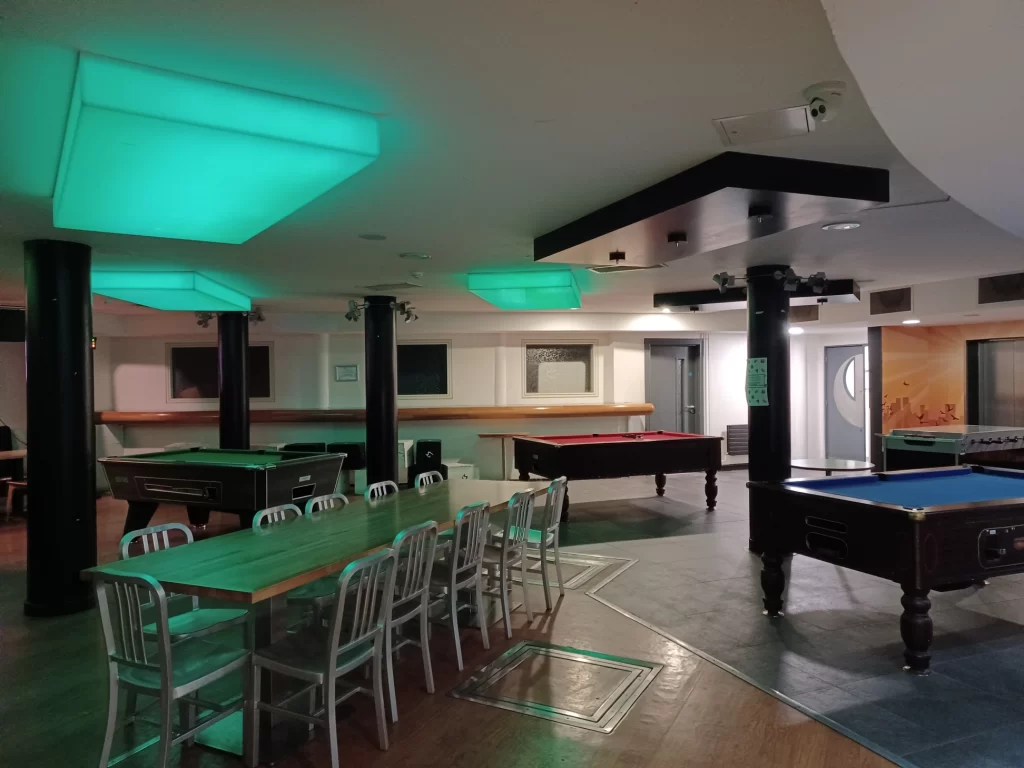
How to Get to and Around Dublin
Many airlines from Europe, North America, Dubai, etc. fly directly to Dublin Airport, Ireland’s busiest airport, with 32.9 million travelers passing through in 2019.
The Dublin Express #782 and Aircoach #700 go to the city centre, which takes 30 to 40 minutes.
Dublin’s public transportation system is very good, and double-decker buses go pretty much anywhere in the city. Fares range from 1.30 EUR to 2.60 EUR for a single trip, depending on how far you’d like to go.
Please note that no change is given back if you pay with the bus driver. Also, it’s important to wave when the bus approaches, otherwise, the bus may just drive by you!
Dublin also has a light rail system (trams) called LUAS, with two lines, that go to Central Dublin and some residential areas (mostly in the south and southwest of the city).
For travel to the suburbs, use the DART trains and Commuter Trains to satellite towns in the Greater Dublin Area, which are operated by Irish Rail. DART goes along the coast side close to Dublin (e.g. Malahide, Howth and Greystones).

If you’re in Dublin for at least 24 hours, it’s best to buy a Visitor Leap Card, as it’s 31% cheaper than buying individual tickets. You can buy it online, at Dublin Airport, or Dublin Central (59 O’Connell Street Upper, Uachtarach, Dublin 1, D01 RX04). It offers unlimited travel on buses, LUAS trams, and DART and Commuter Trains (within the Short Hop Zone, i.e. all of Dublin City and county).
If you’re just staying in and around Dublin, renting a car is not necessary. Traffic is often very busy and parking spots can be hard to find and expensive. Moreover, driving on the left side of the road can be a challenge for tourists used to driving on the opposite side.
Uber and taxis are of course available, but can be expensive.
You can also join a bike tour or walking tour of Dublin to get lots of insider information from a local guide. Or renting a bike or just walking around are great ways to explore the city as well, especially because many attractions are within the City Centre.
Be sure to look into the right directions before crossing a street (there are some helpful writings on some roads as well).
My Opinion on Dublin
Wow, we loved our stay in Dublin! It gave us a great first impression of what Ireland is like. The many red brick buildings are very cool as well.
Although it rains a lot in Dublin, there are lots of indoor things to do, whether it’s shopping at a mall, touring one of the many museums, or hanging and drinking at a pub, lol! So pack some rain gear and just hope for the best! 😉

We also meet some friendly Dubliners, who make us feel very welcome in their city, like our guides, hotel receptionists, bus drivers, or taxi drivers. They all have cool stories to tell, and their sense of humour makes us laugh a lot!
One of the cab drivers truthfully says that the Guinness at the Guinness Storehouse is the most expensive in Ireland, lol! Another one raves about tasty Indian food in Dubai, then tells us that while Dublin is beautiful, visitors should also spend some time in the rest of Ireland!
My favourite things to see and do in Dublin are the Irish Rock’n’Roll Museum and the EPIC Museum, hanging at the parks, and shopping at George’s St Arcade.
But you can’t see everything Dublin has to offer in just a few days! So I hope to visit some of its literary attractions someday (Chester Beatty Library, Oscar Wilde Statue, a Literary Pub Crawl, etc.). So until then, I’m gonna read some books by Irish authors!
I’d also love to see the Old Jameson Distillery, the National Leprechaun Museum, a few art galleries, and some underrated attractions next time. So if you have any tips, let me know in the comments! Sláinte! 😀
If your kids are joining you on your Dublin trip, don’t miss Christine’s post:
10 Things To Do in Dublin With Kids
For other cool places in Ireland, check out my blog posts below:
How To Spend A Day in Athlone, Ireland
A 3-Day Travel Guide for Killarney, Ireland
How to Spend a Perfect Day in Howth, Ireland
- 9 REASONS TO VISIT LEIPZIG, GERMANY FOR A DAY - April 7, 2025
- ONE DAY IN ANCONA, ITALY: THE 6 BEST THINGS TO DO IN 2025 - February 28, 2025
- THE ULTIMATE SOUTH COAST OF ICELANDITINERARY: THE PERFECT DAY TRIP FROM REYKJAVIK - February 1, 2025
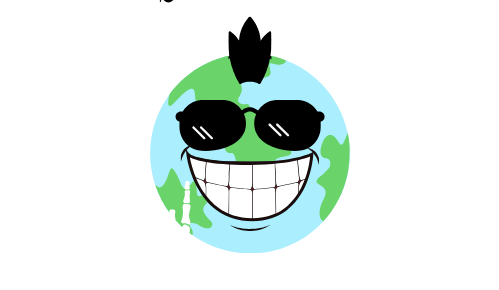

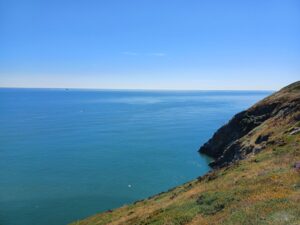

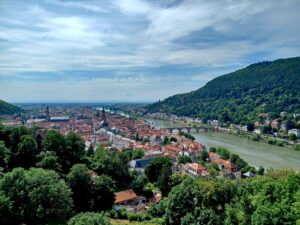
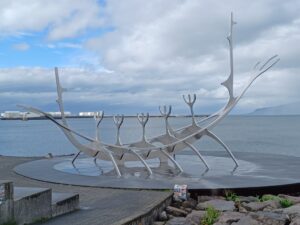

Leave a Reply